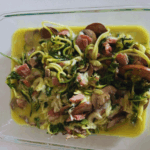This post is Day 19 of solo backpacking the SHT with MCAS continuing my journey on the Superior Hiking Trail with a chronic condition called Mast Cell Activation Syndrome (MCAS).
Table of Contents
Sonju Lake
Since my last hiking trip, I took a getaway with my husband to an eco-retreat called Journey Inn Bed and Breakfast in Maiden Rock, WI to celebrate our 29th wedding anniversary. I’d chosen it because they offered gluten-free meals, and it did not disappoint!
We also had an amazing dinner at Chef Shack in Bay City, WI featuring a five-course Peruvian-French “Summer Midwest Delicacies” tasting menu. Eating out is often stressful for me due to my food sensitivities. Since I don’t drink alcohol I was expecting to order bubbly water, but the owner immediately whipped up an amazing zero-proof drink for me that was so delicious. All but one item that evening was gluten-free, and I left feeling completely cared for by the warm hosts who went out of their way to make my experience enjoyable. Five stars!!
After our special weekend, I was excited to get back on the Superior Hiking Trail this week. The weather forecast looked like it would be clear and not too hot, but it was warmer than expected. Temperatures the previous week had dipped into the low 40s so I switched out some of my clothing for warmer options. Actual temperatures hit the mid-70s for two of the four days I was on the trail. When it was breezy it was comfortable. The bugs weren’t much of an issue, so it was fine that I had left my bug shirt behind.
I dropped off my car at the Highway 1 trailhead near Tettegouche State Park and got a ride from a trail angel to Crosby Manitou State Park. I felt lucky to get the last parking space in the small lot, and I was beginning to realize that there were a lot more people on the trail than on my previous section hikes.
Typically I’ve paid Superior Shuttle service for a ride, but this time I was far enough from their base that the cost was prohibitive. I posted a request on the SHT Facebook group; fortunately, a trail angel told me she lived in the area and could take me. The trail angel had completed the entire SHT last year, and it was fun to hear her favorite spots and to get a preview of what was coming up for me on this section. I tried to offer her payment for the ride, but she refused, saying she enjoyed meeting hikers and helping out. So sweet!
The hike into Sonju Lake was about six miles through aspen and maple forests and then along the Baptism River East Branch. At the Baptism River crossing the bridge was out of commission (see photo of the ruined bridge) so I took a short re-route onto a dirt road. There were quite a few day hikers at the Sonju Lake Trailhead and as usual I got equal parts funny looks and compliments about my bug pants.
There are two campsites at Sonju Lake and I opted for the South one, which featured Lilly Island. A short boardwalk next to the campsite through marshland connected to a cute little rocky island with a few trees and easy access to the water.
I prefer to camp alone but with the many hikers I saw on the trail I guessed that I’d be sharing a campsite; at dinnertime, I met another section hiker who was a retired Spanish teacher from UMD. Another section-hiking couple stopped by on their way to the adjacent campsite. After dinner, I spent the evening in my tent reading a book. It was muggy out but I was so grateful to be back on the trail!!





What is MCAS?
Mast Cell Activation Syndrome (MCAS) is a chronic condition that affects all organ systems. It can cause severe, disabling symptoms every day, including potentially fatal anaphylaxis. MCAS often occurs with other chronic conditions like Ehlers-Danlos Syndrome (EDS) and Postural Orthostatic Tachycardia Syndrome (POTS). Managing MCAS is challenging because many healthcare providers are unaware of it, and diagnostic tests can be unreliable. Treatments involve using antihistamines, mast cell stabilizers, and avoiding triggers. Check out this post on how to manage MCAS.
The bucket theory
The bucket theory simplifies understanding symptom reactions with MCAS. Imagine your body as an empty bucket you don’t want to overflow. Reactions to various stimuli fill the histamine bucket at different rates, forming the total histamine level (how full your bucket is). More histamine means more symptoms. By managing triggers, reducing exposures, and taking medications and supplements, you can control your bucket’s level.
Know your typical symptom progression
Knowing your symptom progression in a symptom flare is the key to developing your rescue plan. This post discusses how to recognize your symptom progression to be prepared to address those symptoms.
Get my free ebook, symptom log, and meal plan!
Want a tool to easily keep track of your symptoms? Sign up for my newsletter and you will receive my free 50-page ebook of lower-histamine, grain-free, sugar-free recipes, my free symptom log, and a free two-week meal plan!
Sign up for the SSP!
The SSP is a listening therapy based on Polyvagal Theory created by Stephen Porges to unlock your ability to think, feel, and connect better through nervous system regulation. You use the SSP via an app on your phone and listen with over-the-ear headphones to specially filtered music that heals the nervous system, specifically the vagus nerve. You subscribe to the app with a provider like me and listen to the specially curated music for 30 minutes each day for a 5-hour cycle. Studies show the SSP has a profound effect on mental health and chronic conditions
You can sign up for the SSP here!
Order my book!
Rocks and Roots chronicles my journey solo backpacking the Superior Hiking Trail and overcoming nervous system dysregulation, gut dysbiosis, and Mast Cell Activation Syndrome symptoms to hike 328 miles successfully.
Check out this powerful frequency device
Healy is an individualized microcurrent device I use to reduce inflammation. Check out this post for more about Healy.
Sign up for a session!
I provide one-on-one in-person and remote chronic illness and caregiver coaching and Sacred Self-Healing Sessions based on the Sacred Self-Healing Method, a proven novel co-creative healing modality detailed in my Books.
Click here for more information.
What do you think?
I’d love to have your reply below!
Disclaimer
The preceding material does not constitute medical advice. This information is for information purposes only and is not intended to be a substitute for professional medical advice, diagnosis, cure or treatment. Always seek advice from your medical doctor.



